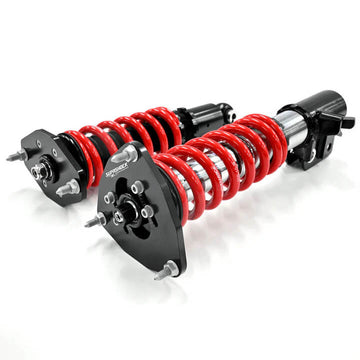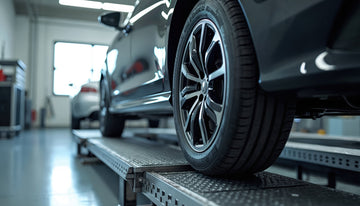Suspension bushings are small components that connect the vehicle's suspension system to the frame of a vehicle. They are designed to provide a cushioning effect and allow for controlled movement between various suspension components.
What are bushings made of?
Suspension bushings are usually made of rubber or polyurethane, and even aluminium. They are placed between different parts of the suspension system, such as control arm bushes, sway bars, and shock absorbers. The primary purpose of bushings is to allow the joining of metal parts without metal-on-metal contact, reduce vibration between parts, absorb impacts, and provide a degree of flexibility while maintaining the structural integrity of the suspension components.
What are some types of suspension bushings?
There are several types of suspension bushings commonly used in automotive applications. Some examples include:
Rubber bushings
Rubber bushings are the most common type and are typically made of a rubber compound bonded to a metal sleeve. They provide a good balance between comfort and durability, absorbing vibrations and reducing noise. Rubber bushings are commonly used in control arms, sway bars, and suspension links.
Polyurethane bushings
Polyurethane bushings are known for their increased stiffness and improved durability compared to rubber bushings. They offer enhanced responsiveness, reducing deflection and providing better control during cornering and braking. Polyurethane bushings are commonly used in performance applications where precise handling is desired.
Aluminium bushings
Aluminium bushings are typically constructed with an outer aluminium shell or sleeve and an inner insert. The aluminium shell provides structural integrity, while the insert reduces friction and allows for smooth movement. Aluminium bushings can withstand high loads and extreme conditions without deteriorating over time. They also offer excellent stability and minimal play, resulting in improved suspension geometry and more accurate handling characteristics.
Key functions of suspension bushings
Vibration and noise reduction
One role of suspension bushings is to help isolate the chassis from vibrations and impacts transmitted by the road surface. By absorbing and dampening these vibrations, they contribute to a smoother and more comfortable ride for the occupants of the vehicle. Additionally, they help reduce noise and harshness caused by the suspension system's movement.
Flexibility and articulation
Suspension bushings allow controlled movement and articulation between different suspension components. This flexibility is crucial for the suspension system to adapt to changes in road conditions, absorb impacts, and maintain proper wheel alignment. By allowing controlled movement, bushings help maintain traction and improve the vehicle's stability and handling.
Component protection
Suspension bushings also serve to protect other components of the suspension system. They help prevent metal-to-metal contact between various parts, reducing wear and extending the lifespan of the suspension components. By providing a cushioning effect, bushings help absorb shocks and prevent damage to the suspension system under rough or uneven road conditions.
Improved steering response
Suspension bushings play a role in maintaining proper alignment and geometry of the suspension system. By providing stability and controlled movement, they contribute to more precise steering response, enhancing the driver's control over the vehicle.
How can I ensure the longevity of my suspension bushings?
Regular inspection
Bushings can wear out over time due to constant movement and exposure to heat, causing suspension system problems such as clunking noises, uneven tire wear, and poor handling. Periodically inspect your suspension bushings for signs of wear, damage, or deterioration. Look for cracks, tears, or excessive play in the bushings. Regular visual inspections can help you identify any issues early on and take appropriate action.
Maintain proper wheel alignment
Proper wheel alignment is crucial for reducing stress on the suspension bushings. Misaligned wheels can cause uneven wear and strain on the bushings. Regularly check and adjust your vehicle's wheel alignment according to the manufacturer's recommendations or when you notice any signs of misalignment, such as uneven tire wear.
Avoid excessive loads
Overloading your vehicle or subjecting it to excessive weight can put unnecessary strain on the suspension bushings. Adhere to the recommended load capacity specified by the vehicle manufacturer to prevent excessive stress on the suspension system.
Drive smoothly and avoid harsh impacts
Aggressive driving, hitting potholes, and driving over speed bumps at high speeds can lead to increased stress on the suspension bushings. Practise smooth driving techniques, avoid harsh impacts, and slow down when encountering road irregularities to minimise the strain on the bushings.
Regular maintenance
Follow the recommended maintenance schedule provided by the vehicle manufacturer. This typically includes tasks such as lubricating bushings (if applicable) and ensuring that other suspension components, such as shocks or struts, are in good condition. Well-maintained suspension components can help reduce the load and stress on the bushings.
Protection from environmental factors
Exposure to harsh weather conditions, extreme temperatures, and chemicals can accelerate the deterioration of suspension bushings. Whenever possible, park your vehicle in a sheltered area or use protective covers to shield it from the elements.
Timely replacement
If you notice signs of significant wear, damage, or deterioration in your suspension bushing, it's important to have them replaced promptly. Delaying replacement can lead to further damage to other suspension components and compromise the overall performance and safety of your vehicle. Proper installation is important for ensuring optimal performance of new bushings. Installing new bushings requires specialised tools and knowledge, so it is recommended to have a professional mechanic perform the work.





